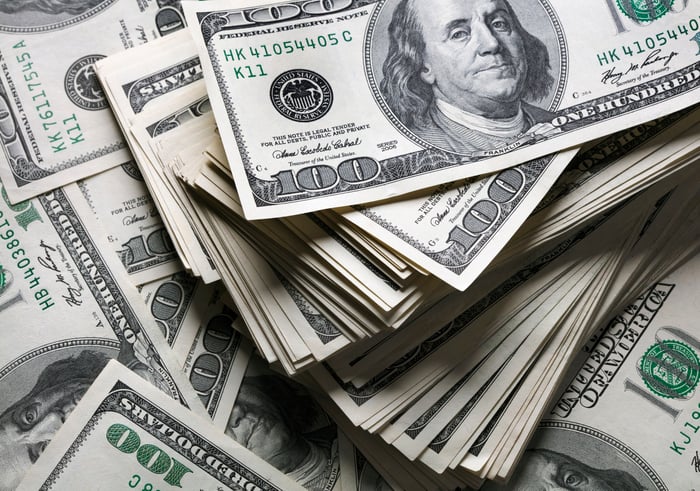In 2021, Wall Street could seemingly do no wrong. The growth-focused Nasdaq Composite climbed to a new all-time high, and the widely followed S&P 500 endured no more than a 5% correction. Last year marked a complete 180. The Dow Jones Industrial Average, S&P 500, and Nasdaq Composite all plunged into a bear market and produced their worst returns since 2008.
Unpleasant years like 2022 are bound to happen. They're the price of investing on Wall Street. Thankfully, they also offer opportunity. No matter how often corrections occur, how long they last, or how steep the major indexes ultimately dip, every last crash, correction, and bear market throughout history has eventually been fully recouped by a bull market.
In other words, the current bear market is a red-carpet buying opportunity for the patient.

Image source: Getty Images.
The thing to understand is you don't have to buy high-volatility stocks to build wealth over time. There are plenty of high-quality businesses trading at a discount that can safely grow your nest egg over the next decade.
What follows are three unstoppable stocks that can safely turn a $350,000 initial investment into $1 million, including dividends paid, by 2033.
NextEra Energy
The first surefire stock that can deliver a roughly 186% return on a starting investment of $350,000 over the next 10 years is electric utility NextEra Energy (NEE -0.37%).
In general, the utility sector is a slow-growth safe haven that conservative investors retreat to for above-average dividend yields and capital preservation. The interesting thing about NextEra is that it provides this safety, while growing considerably faster than most utility stocks.
Before digging into company specifics, let's touch on the basics: Electricity is a basic need service. If you own or rent a home, there's a good chance you need electricity to power your appliances and, possibly, your heating/cooling system. Regardless of how the U.S. economy is performing, demand for electricity isn't going to vacillate much from one year to the next.
Furthermore, most electric utility providers operate as monopolies. Since electrical grids and infrastructure doesn't grow on trees, consumers have limited choice, or perhaps no choice, as to which company services their household. This reinforces the idea that electric utility operating cash flow tends to be predictable.
What makes NextEra Energy such a special investment is its 30-gigawatt (GW) renewable energy portfolio. No other utility on the planet is generating more capacity from wind (22 GW) or solar (5 GW) power.
Despite these clean-energy investments costing a pretty penny, they're helping to dramatically lower electricity generation costs. The result is a compound annual adjusted earnings growth rate for NextEra of 8.3%, as well as a compound annual dividend growth rate of 9.9%, over the past 15 years.
Renewable energy is, absolutely, NextEra's identity. From 2023 through 2026, the company anticipates building between 33 GW and 42 GW of new clean-energy and storage projects.
The other half of NextEra Energy's operations -- i.e., those not powered by renewable energy sources -- are regulated by Florida's Public Service Commission (FPSC). Although NextEra needs the approval of the FPSC before it can issue rate increases, this oversight ensures that the company isn't exposed to potentially volatile wholesale electricity pricing.
In short, NextEra Energy is a growth stock among stodgy electric utilities -- and it has a 2.5% yield to boot.
Innovative Industrial Properties
A second unstoppable stock that can safely grow an initial investment of $350,000 into a cool $1 million by 2033, when accounting for dividends, is real estate investment trust (REIT) Innovative Industrial Properties (IIPR -0.72%), more commonly known as IIP.
REITs are businesses that acquire properties with the intent of leasing them out for an extended length of time. REITs avoid the normal corporate income-tax rate in exchange for paying out a majority of their net earnings in the form of a dividend to their shareholders.
While IIP is a REIT, it's far from a traditional one. As of the end of 2022, it owned 110 properties spanning 19 states that were predominantly involved in medical marijuana cultivation or processing. The weighted average remaining lease length of these properties is a little over 15 years.
Until recently, it was business as usual for Innovative Industrial Properties. But as of February 2023, the company was only collecting 92% of its rents on time. A rash of recent delinquencies has skeptics concerned that the buzz surrounding cannabis REITs like IIP may be fading.
However, all REITs eventually face delinquencies. It's how they respond to those delinquencies that needs to be closely monitored by investors. Considering that IIP stuck to its quarterly dividend, as well as laid out specifics of how it's addressing each delinquency in its operating results, long-term investors should feel reassured that management is steering IIP in the right direction, despite choppy waters in the short run.
One of the top reasons IIP can be counted on to deliver for patient investors is the structure of its leases. The entirety of its portfolio is triple net leased (also referred to as "NNN" leased). NNN leases require the tenant to cover all property costs, including utilities, maintenance, property taxes, and even insurance costs. The advantage of this lease structure is it removes the adverse impact of surprise expenses from the equation, which tends to lead to highly predictable cash flow.
In addition, lack of cannabis reform on Capitol Hill is actually helping IIP's bottom line. As long as marijuana remains illicit at the federal level, access to basic financial services will be limited for multi-state operators (MSOs). Innovative Industrial Properties has remedied this by purchasing properties with cash and immediately leasing them back to the seller. This win-win puts cash into the hands of MSOs and nets IIP long-term tenants.
Innovative Industrial Properties is yielding 9.5%, has grown its dividend by 1,100% in a little over five years, and is trading at 13 times Wall Street's forecast earnings for 2024. It looks like an amazing deal for patient investors.

Image source: Getty Images.
Mastercard
The third unstoppable stock that can safely turn a $350,000 investment into $1 million by 2033 is payment-processing giant Mastercard (MA -0.33%).
Aside from the crisis of confidence affecting U.S. and European banks, which isn't a direct concern for Mastercard, the biggest worry for financial stocks is that they'll succumb to a U.S. or global recession. It's normal for consumer and enterprise spending to taper off during a recession, which wouldn't be positive for Mastercard's sales or profits.
But being cyclical is a two-way street -- and the length of this street differs dramatically. Whereas every recession since the end of World War II has taken two months to 18 months to run its course, economic expansions usually last for years, if not a decade. Mastercard is disproportionately benefiting from extended periods of U.S. and global growth.
One thing that certainly doesn't hurt is having a key role in the top market for consumption worldwide. Mastercard has established itself as the clear No. 2 in the U.S., with close to 24% of credit card network purchase volume.
However, it's the international markets that should allow Mastercard to sustain an annual growth rate of around 10% for many years to come. Globally, more than half of all transactions are still being facilitated with cash. This gives a giant like Mastercard the ability to acquire its way into underbanked regions, or to organically push into emerging/developing markets.
Another reason Mastercard can shine is due to its laser-focus on payment processing. Though some of its payment-processing peers have chosen to lend, Mastercard has not. While it is giving up the opportunity to collect interest income as a lender, the trade-off is it's not responsible for loan losses when economic downturns arise. In short, Mastercard doesn't have to set aside capital when recessions occur, which allows it to bounce back considerably faster than its peers.
With a forward-year price-to-earnings (P/E) ratio of 24, Mastercard isn't "cheap" by traditional standards. But given its steady double-digit growth, a forward P/E of 24 is the cheapest Mastercard has been since 2018. That's a green light for long-term investors to buy.





